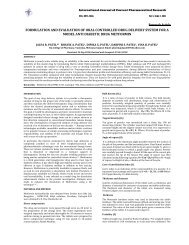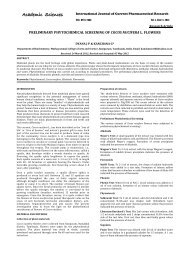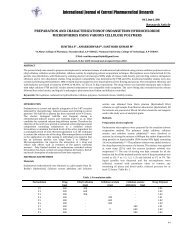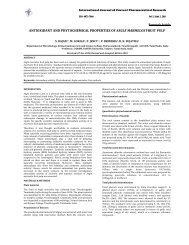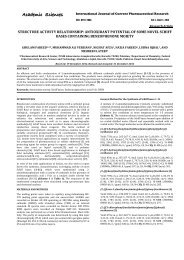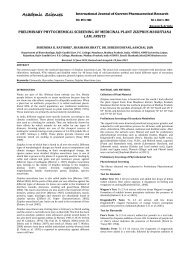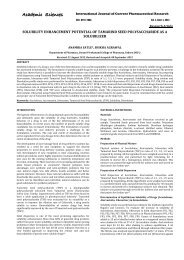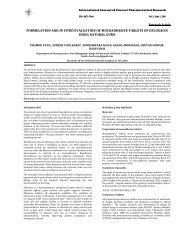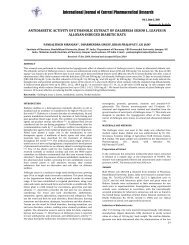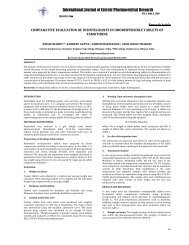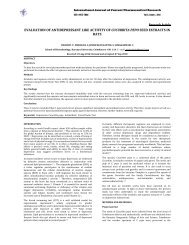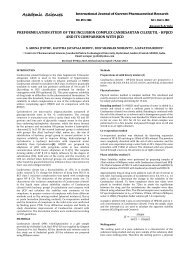design and evaluation of controlled release mucoadhesive buccal ...
design and evaluation of controlled release mucoadhesive buccal ...
design and evaluation of controlled release mucoadhesive buccal ...
Create successful ePaper yourself
Turn your PDF publications into a flip-book with our unique Google optimized e-Paper software.
International Journal <strong>of</strong> CURRENT PHARMACEUTICAL RESEARCHISSN- 0975-1491 Vol 2, Issue 4, 2010Research ArticleDESIGN AND EVALUATION OF CONTROLLED RELEASE MUCOADHESIVE BUCCAL TABLETS OFLISINOPRILGUDA ADITYA *1 , GANESH KUMAR GUDAS 1 , MANASA BINGI 2 , SUBAL DEBNATH 1 , V.V.RAJESHAM 11Sri Krupa Institute <strong>of</strong> Pharmaceuticals Sciences, Village: vellkatta, Mondal: Kondapak, Dist: Medak, A.P. – 502 277. 2 Vaagdevi PharmacyCollege, Bollikunta, Warangal. Email: subal_2007@yahoo.co.inReceived: 09 Jun 2010, Revised <strong>and</strong> Accepted: 6 July 2010ABSTRACTLisinopril, a drug widely used in the treatment <strong>of</strong> hypertension. However, its extensive first pass metabolism results in poor bioavailability. Theobjective <strong>of</strong> present research work is to <strong>design</strong> <strong>and</strong> evaluate the <strong>controlled</strong> <strong>release</strong> <strong>of</strong> <strong>mucoadhesive</strong> <strong>buccal</strong> tablets <strong>of</strong> Lisinopril with a goal toincrease the bioavailability, reduce dosing frequency <strong>and</strong> improve patient compliance. The tablets were prepared using Carbopol‐934, Hydroxypropyl methyl cellulose (HPMC), Hydroxy ethyl cellulose (HEC) as <strong>mucoadhesive</strong> polymers. Six formulations were developed with varyingconcentration <strong>of</strong> polymers. The tablets were evaluated for hardness, weight variation, thickness, percentage <strong>of</strong> drug content, Surface pH, invitrostudies like swelling, <strong>mucoadhesive</strong> strength <strong>and</strong> drug <strong>release</strong>. Formulation (F4) containing Carbopol‐934 <strong>and</strong> HPMC K4M in the ratio <strong>of</strong> (2 : 4)showed good <strong>mucoadhesive</strong> strength (36.8) <strong>and</strong> maximum drug <strong>release</strong> <strong>of</strong> 97.1% in 10 hrs. Swelling increase with increase in concentration <strong>of</strong>HPMC K4M in tablets. Swelling pH was found to be 6.10. Formulation (F4) follows zero‐order drug <strong>release</strong>. FTIR studied showed no evidence oninteraction between drug <strong>and</strong> polymers. The results indicate that the <strong>mucoadhesive</strong> <strong>buccal</strong> tablets <strong>of</strong> Lisinopril may be good choice to bypass theextensive hepatic first pass metabolism with an improvement in the bioavailability <strong>of</strong> Lisinopril through <strong>buccal</strong> mucosa.Keywords: Lisinopril, Mucoadhesive, Control <strong>release</strong>, Swelling index, HPMC, CarbopolINTRODUCTIONMucoadhesive drug delivery systems are delivery systems, whichutilize the property <strong>of</strong> bioadhesion <strong>of</strong> certain polymers. Bioadhesionis defined as an ability <strong>of</strong> a material to adhere a particular region <strong>of</strong>the body for extended period <strong>of</strong> time not only for local targeting <strong>of</strong>drugs but also for better control <strong>of</strong> systemic delivery. Mucoadhesive<strong>buccal</strong> drug delivery systems <strong>of</strong>fer many advantages overconventional systems such as ease <strong>of</strong> administration, rapidtermination <strong>of</strong> therapy <strong>and</strong> administration to unconscious patients.Drug which are destroyed by the enzymatic/alkaline environment <strong>of</strong>the intestines are unstable in the acidic environment <strong>of</strong> the stomachcan be administered by this route 1 .From technical point <strong>of</strong> view, an ideal <strong>buccal</strong> dosage form must havethree properties. It must maintain its position in the mouth for a fewhours, <strong>release</strong> the drug in a <strong>controlled</strong> fashion <strong>and</strong> provide the drug<strong>release</strong> in a unidirectional way towards the mucosa. In regard to thefirst requirement, strong adhesive contact to the mucosa inestablished by using <strong>mucoadhesive</strong> polymers as excipients. If the<strong>mucoadhesive</strong> excipients are able to control drug <strong>release</strong>, the secondrequirement can be fulfilled by preparing a system have uniformadhesiveness <strong>and</strong> impermeable backing layer. Various<strong>mucoadhesive</strong> devices such as include tablets, film, patches, discs,strips, ointments <strong>and</strong> gel have been recently developed 2 .Most <strong>of</strong> the <strong>mucoadhesive</strong> materials are either synthetic or naturalhydrophilic or water insoluble polymers <strong>and</strong> are capable <strong>of</strong> formingnumerous hydrogen bonds because <strong>of</strong> presence <strong>of</strong> the carboxyl,sulphate or hydroxyl functional groups. Various materials weretested for mucoadhesion. The synthetic materials include Carbopol‐934, Hydroxy propyl methyl cellulose (HPMC), Hydroxy ethylcellulose (HEC), Sodium carboxy methyl cellulose, Polymethylmethacrylates <strong>and</strong> polycarbophil, while natural polymers includexantium gum, sodium alginate, gelatin, acacia <strong>and</strong> tragacanth 3 . Thebioadhesive polymers can not only cause the adhesion effects butcan also control the <strong>release</strong> rate <strong>of</strong> drug.Lisinopril is widely used in the treatment <strong>of</strong> hypertension which isan ACE inhibitor. It has biological half life (4 to 5 hrs). The objective<strong>of</strong> present study is to <strong>design</strong> <strong>and</strong> evaluate the <strong>controlled</strong> <strong>release</strong> <strong>of</strong><strong>mucoadhesive</strong> <strong>buccal</strong> tablets <strong>of</strong> Lisinopril with a goal to increase thebioavailability, reduce dosing frequency <strong>and</strong> improve patientcompliance, employing the <strong>mucoadhesive</strong> polymers like Carbopol‐934, Hydroxy propyl methyl cellulose (HPMC), Hydroxy ethylcellulose (HEC). The <strong>buccal</strong> tablets were evaluated for hardness,weight variation, thickness, percentage <strong>of</strong> drug content, surface pH,invitro studies like swelling, <strong>mucoadhesive</strong> strength <strong>and</strong> drug<strong>release</strong> 4 .MATERIALS AND METHODSMaterialsLisinopril was received as gift sample from Alembic Ltd., Vadodara ,Gujarat. Carbopol‐934, Hydroxy Propyl Methyl cellulose (HPMC),Hydroxy ethyl cellulose (HEC) were procured as gift samples fromCipla Ltd., Mumbai, India. All other reagents <strong>and</strong> chemical used <strong>of</strong>analytical grade.Preparation <strong>of</strong> <strong>mucoadhesive</strong> <strong>buccal</strong> tablets 5Mucoadhesive <strong>buccal</strong> tablets, each containing 10 mg Lisinopril wereprepared by direct compression method. Composition <strong>of</strong> variousformulations employing Carbopol 934P, HPMC K4M & HEC areshown in Table 1. All the ingredients <strong>of</strong> tablets were blended inmortar with a pestle for 15 min to obtain uniform mixture. Theblended powder was then compressed into 150 mg tablets (at 5‐7kg/cm 2 ) on a single stoke, 10 station rotary tablet machine(Cadmach Machinery Co. Pvt. Ltd., Ahmedabad, india) with 8mmround shaped flat punch.Evaluation <strong>of</strong> tabletsThe tablets from different formulation (F1 to F6) were subjected t<strong>of</strong>ollowing testsHardnessTablets were evaluated for their hardness using Monsanto hardnesstester.Weight variationTen tablets from each formulation were weighed using an electronicdigital balance <strong>and</strong> the average weight was calculated. The resultsare shown in Table‐2.ThicknessTablets were evaluated for their thickness using slide calipers. Theresults are shown in Table 2.Content uniformityTen tablets from each formulation were taken, crushed <strong>and</strong> mixed.From the mixture, 10 mg <strong>of</strong> Lisinopril equivalent <strong>of</strong> mixture was
Aditya et al.Int J Curr Pharm Res, Vol 2, Issue 4, 2427Kinetic treatment to dissolution dataKinetic studies i.e. zero‐order, first order <strong>and</strong> Higuchi <strong>and</strong> Hixcon‐Crowell were conducted for all formulations <strong>and</strong> the data is shownin Table 6.The value <strong>of</strong> regression correlation co‐efficient (R 2 ) wasevaluated for all the formulations which value was close to 0.99.Hence it is conducted that all the formulations are following thezero‐order drug <strong>release</strong>.CONCLUSIONThe overall studies indicated that the polymers Carbopol 934p <strong>and</strong>HPMC K4M in the ratio <strong>of</strong> 2 : 4 showed satisfactory <strong>mucoadhesive</strong>properties. Among the 6 formulations, the formulation F4 usingthese polymers in the above ratio with drug exhibited significantswelling properties with optimum <strong>release</strong> pr<strong>of</strong>ile. Hence it can beconcluded that the formulation F4 will be useful for <strong>buccal</strong>administration for the treatment <strong>of</strong> anti‐hypertensive. So, the<strong>mucoadhesive</strong> <strong>buccal</strong> tablets ot Lisinopril may be a good choice tobypass the extensive hepatic first pass metabolism with animprovement in the bioavailability <strong>of</strong> Lisinopril through Buccalmucosa.REFERENCES1. Bhupinder Singh, Sukhwinder Kaur Chakkal, <strong>and</strong> Naveen Ahuja.Formulation <strong>and</strong> Optimization <strong>of</strong> Controlled ReleaseMucoadhesive Tablets <strong>of</strong> Atenolol Using Response SurfaceMethodology. AAPS PharmSciTech 2006; 7 (1) : Article 3.2. K. P. R. Chowdary, B. Suresh, B. Sangeeta <strong>and</strong> G. KamalakaraReddy, Design And Evaluation Of Diltiazem MucoadhesiveTablets For Oral Controlled Release, Saudi PharmaceuticalJournal 2003; 11 (4) : 201‐205.3. KP Chowdary, RG Kamalakara, Controlled Release <strong>of</strong> Nifedipinefrom Mucoadhesive Tablets <strong>of</strong> Its Inclusion Complex,Pharmazie 2003; 58 : 721‐4.4. Bhupinder Singh , Sukhwinder Chakkal, Naveen Ahuja.Formulation <strong>and</strong> Optimization <strong>of</strong> Controlled ReleaseMucoadhesive Tablets <strong>of</strong> Atenolol Using Response SurfaceMethodology. AAPS Pharm Sci Tech 2006; 7 (1) : 22‐26.5. Shaila Lewis, G Subramanian, S P<strong>and</strong>ey, N Udupa. Design,Evaluation <strong>and</strong> Pharmacokinetic Study <strong>of</strong> Mucoadhesive BuccalTablets <strong>of</strong> Nicotine for Smoking Cessation. Indian J Pharm Sci2006; 68 (6) : 829‐831.6. Avachat A, Kotwal V. Design <strong>and</strong> Evaluation <strong>of</strong> Matrix‐BasedControlled Release Tablets <strong>of</strong> Dicl<strong>of</strong>enac Sodium <strong>and</strong>Chondroitin Sulphate. AAPS PharmSciTech 2007; 8 (4) : Article88.a. Rajasekaran, V. Sivakumar, K. Karthika, J. Padma Preetha, T.Abirami. Design <strong>and</strong> Evaluation <strong>of</strong> Polymeric ControlledRelease Natamycin Ocular Inserts. Kathm<strong>and</strong>u UniversityJournal <strong>of</strong> Science, Engineering <strong>and</strong> Technology 2010; (1) : 108‐115.7. Rajesh Khanna, Suraj P. Agarwal Alka Ahuja. Muco‐adhesiveBuccal Tablets <strong>of</strong> Clotrimazole for Oral C<strong>and</strong>idiasis. DrugDevelopment <strong>and</strong> Industrial Pharmacy 1997; 23 (8) : 831 –837.8. Perioli L, Ambrogi V, Giovagnoli S, Ricci M, Blasi P, Rossi C.Mucoadhesive Bilayered Tablets for Buccal Sustained Release<strong>of</strong> Flurbipr<strong>of</strong>en. AAPS Pharm Sci Tech 2007; 8 (3) : Article 54.9. Lalla JK, Bhat SU. Controlled‐<strong>release</strong> Isosorbide DinitratePellets. Part I: Design <strong>and</strong> <strong>evaluation</strong> <strong>of</strong> <strong>controlled</strong>‐<strong>release</strong>capsule dosage form. J Pharm Sci. 1993; 82 (12) : 1288‐91.27



